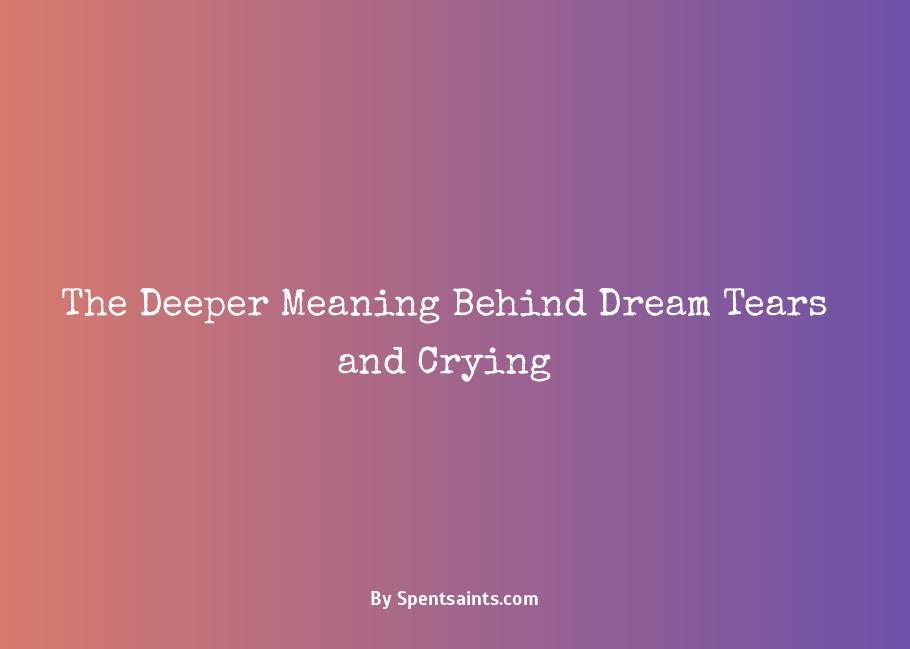Dreams have long fascinated humankind as windows into our unconscious minds. Among the mysterious symbols that can appear in dreams, episodes of crying often stir our curiosity. What could dream tears signify spiritually about deeper parts of ourselves?
Exploring dream crying means tuning into your inner self on a profound level.
Spiritual Meaning of Crying in Dreams
Dreaming of crying has layered symbolic meanings from a spiritual perspective. Tears in dreams often represent:
- Emotional release or cleansing
- Processing grief, trauma, or other struggles
- Letting go of past baggage
- Healing inner pain or wounds
- Feeling overwhelmed by life events
- A desire for comfort and nurturing
- Expressing vulnerability
Essentially, dream crying signals intense emotions needing to emerge from your subconscious. Your soul may be guiding you to acknowledge and process deeply buried feelings.
Alternatively, happy dream tears can indicate:
- Relief after enduring difficult trials
- Releasing tension
- Experiencing a spiritual breakthrough
- Feeling moved by beauty or inspiration
- Profound gratitude
These interpretations emphasize dreams as opportunities for self-discovery and spiritual growth. Your dream tears are meaningful messages from within. However, common assumptions that all dream crying is negative or unimportant can cause people to dismiss these valuable insights.
Jung’s Perspective on Dream Crying
Carl Jung viewed crying dreams as highly significant. He believed tears symbolize the release of unconscious emotions necessary for the dreamer’s psychological health and wholeness. From this lens, paying attention to dream crying becomes vital.
Cultural Views on Dream Crying
Across cultures, varied beliefs exist about crying dreams:
- Some Native American tribes consider crying dreams good fortune.
- In Korean folklore, dream weeping may indicate a wedding is imminent.
- Ancient Egyptians linked dreams of mourning with death omens.
- Some Eastern traditions interpret crying dreams as wish fulfillment.
Examining cultural perspectives reveals humanity’s shared fascination with dream tears.
Common Dream Scenarios Involving Crying
Certain dream scenarios tend to evoke tears more often. Some typical crying dream themes include:
- Crying alone – Feeling isolated in grief or despair.
- Someone else crying – Empathizing with another’s pain or your own projected feelings.
- Can’t stop crying – Overwhelmed by painful emotions or trauma.
- Crying in public – Releasing private feelings openly.
- Crying over lost loved one – Processing grief and unfinished business.
Dream contexts offer clues about which repressed emotions may be emerging. Notice where the tears flow for deeper insight.
Unusual Crying Dream Locations
Take note if dream crying happens somewhere strange or absurd. Weird locations may represent:
- A workplace – Feeling emotionally unfulfilled by your career.
- A childhood home – Unresolved issues from the past.
- Underwater or the sky – Powerful feelings emerging from the depths of your unconscious.
- A public bathroom – Needing privacy to express vulnerable emotions.
Bizarre dream spaces often symbolize the inner world. Analyze why your subconscious chose that setting for releasing emotions.
Interpreting the Symbolism of Dream Crying
Besides the actual tears, crying dreams also use symbolic imagery. Analyze symbols that appear for deeper meaning:
- Water – Emotions, spirituality, the unconscious
- Rain – Sadness, grief, release, renewal
- Rivers or oceans – Overwhelming emotions, the collective unconscious
- Mirrors – Self-reflection, identity issues
- Childhood home or school – Unresolved wounds from youth
- Dungeon or cage – Feeling trapped by trauma
Linking dream symbols to crying imagery provides greater insight into your subconscious world. Record all details for reflection.
Colors Associated with Dream Crying
Color symbolism can also illuminate the meaning behind dream tears:
- Red – Intense anger or outrage.
- Blue – Sadness, grief, or despair.
- Black – Emptiness, loss, or depression.
- Green – Jealousy, envy, or bitterness.
- White – Relief, surrender, or peace.
Notice colors throughout the dream for clues about associated emotions. Bright colors may signal ready to emerge feelings, while darker shades often relate to what remains unconscious.
Emotional Release Through Dream Tears
Rather than brushing off dream crying, embrace it for emotional cleansing. Healthy ways to process dream tears include:
- Recording dreams immediately upon waking.
- Journaling to explore dream reflections.
- Discussing dreams with a trusted friend or therapist.
- Expressing dream feelings through art, music, or movement.
- Meditating to achieve catharsis.
- Using dream imagery for inner child work.
By honoring the healing potential of dream tears, you integrate your conscious and unconscious worlds more profoundly. Dream crying prepares you for spiritual awakening.
Lucid Dreaming for Emotional Insight
If you become lucid during dream crying, you can actively engage with the experience for self-analysis. Lucid techniques like asking the dream to explain the tears’ meaning or conjuring a wise guide for consultation can provide direct access to your emotions.
Active Imagination for Dream Integration
Try re-imagining your dream while awake using active imagination. Change details, express hidden feelings, or resolve unfinished business with dream characters to find catharsis. This integrates dream insights fully into everyday life.
To fully benefit from dream crying, integrate lessons and insights into daily life:
- Practice self-compassion – Be gentle with yourself as you process difficult emotions.
- Explore psychotherapy – A therapist can help interpret dream symbolism.
- Improve emotional wellness – Try breathwork, meditation, journaling, exercise, time in nature, or counseling.
- Examine your environment – Make changes to reduce stressors that may trigger dream crying.
- Foster human connection – Don’t isolate yourself as you work through dream feelings.
Ultimately, dream crying reveals that wounds must feel before they can heal. By courageously exploring the spiritual messages in your tears, you free yourself to awakening and joy.
Dream crying connects us to a vast unconscious realm filled with insight, but we must bravely enter its waters. Those willing to dive into the depths of their dream tears are rewarded with self-discovery, emotional clarity, and profound spiritual renewal.

Dreams, spirit, growth – I explore them all. Laugh, learn, grow with me. Unlock your inner guru.
